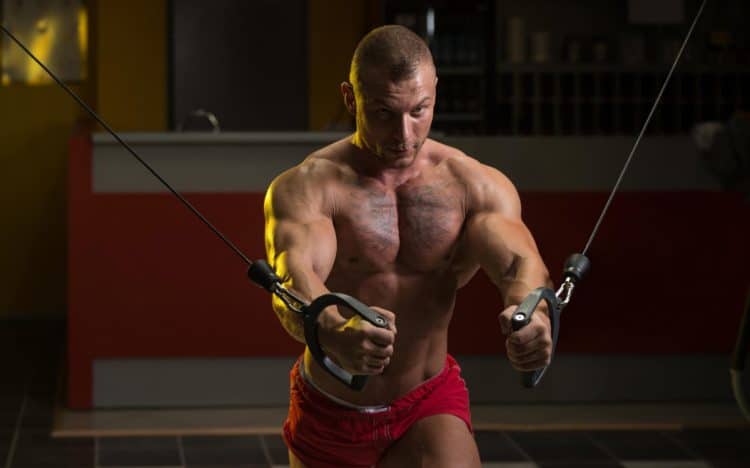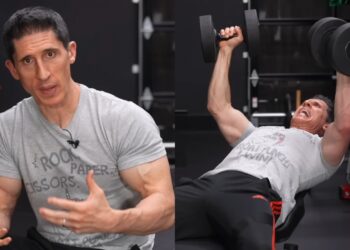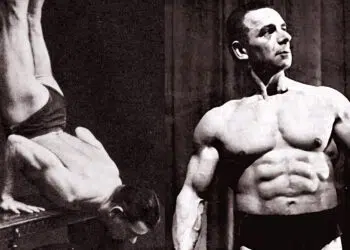Anyone looking to build an aesthetic physique cannot overlook the chest. A barrel chest has been the cornerstone of strength, power, and masculinity since time immemorial, and the trend isn’t going to change anytime soon.
As a veteran bodybuilding coach with over 17 years in the trenches, I can attest that the upper chest is a lagging muscle group for many lifters. Exercises like the flat barbell bench press and flyes are excellent for building the middle and lower chest. However, they do little for the upper pecs.
After spending over 50 hours studying different exercises and their effectiveness in targeting the upper chest, I discovered an almost forgotten exercise that outshines almost every other lift to bias the upper pecs — the guillotine press.
In this article, I take you over the often-overlooked guillotine press, its benefits, correct techniques, and how to incorporate it into your routine to transform your upper chest and build a shelf that even Arnold Schwarzenegger would envy.
Understanding the Guillotine Press
Let’s delve into the biomechanics of the guillotine press to understand how it can carve a chiseled chest:
Level Up Your Fitness: Join our 💪 strong community in Fitness Volt Newsletter. Get daily inspiration, expert-backed workouts, nutrition tips, the latest in strength sports, and the support you need to reach your goals. Subscribe for free!
The effectiveness of an exercise to target a particular muscle group ultimately comes down to its biomechanics. The guillotine press has a similar setup to the traditional bench press. However, it involves lowering the barbell to the neck (or collarbone) instead of the nipple line. This unique line of pull results in a deep upper chest stretch, maximizing muscle activation and growth.
It might sound risky (and it is if done incorrectly), but using the proper form ensures safety and maximum effectiveness.
Furthermore, this exercise is performed with a wider grip than the conventional bench press, which encourages you to flare your elbows on the lowering phase. The increased range of motion (ROM) intensifies the stretch and mind-muscle connection. (1)
Contrary to what most people think, the upper chest is not just important for aesthetics. It helps build overall upper body strength, improving performance in other compound exercises and daily tasks.
“The guillotine press is a flat bench press variation where you shrug your shoulders and flare your elbows as you lower the barbell to your neck. While some people argue that this exercise can cause shoulder problems, there is no scientific evidence to support this claim.” — Jeff Nippard (Natural bodybuilder and fitness content creator)
Mastering the Guillotine Press Technique
Below is a step-by-step guide to performing the guillotine press to get the best bang for your buck:
Step One: Set Up
Set up a barbell on a flat bench and load it with an appropriate weight. Grab the bar with a wider-than-shoulder-width grip. Feel free to go as wide as double shoulder width.
Retract your shoulder blades and arch your lower back so there is enough space between the bench and your back for your hand to pass. Plant your feet flat on the floor and drive your heels into the floor.
Pro Tip: I recommend starting with just a 45-pound barbell until you learn the proper movement mechanics.
Step Two: Unrack and Descend
Take a deep breath and unrack the bar while keeping your elbows locked out. Hold the bar above your middle chest level. Then, slowly lower the bar toward your neck while flaring your elbows. Go as low as you can, ideally gently touching the bar to the base of your neck at the bottom.
Pro Tip: Three-second eccentrics are a great place to start. Use slower tempos as you gain more experience.
Step Three: Pause and Press
Pause in the bottom position for a good two seconds to maximize the stretch. It might feel uncomfortable, but this is where the growth happens.
Drive the bar back up explosively to the starting position. Think about pushing your torso through the bench into the floor during the lifting phase to generate more power.
Repeat for recommended reps.
Pro Tip: Avoid locking out your elbows at the top to maintain constant tension on the target muscles throughout the ROM.
Safety Tips For the Guillotine Press
Adhere to the following guidelines to minimize the risk of getting hurt while performing this exercise:
Warm-Up
The bench press incorporates your chest, shoulders, triceps, back, core, and legs. You must warm up thoroughly to prime your muscles for this compound exercise. A five-minute warm-up routine comprising dynamic stretches like arm swings, rotator cuff exercises, and lighter sets of bench presses is a great place to start.
Controlled Descent
Lowering the bar with utmost control is the most important aspect of this lift. It ensures the target muscles are moving the weights and limits injury risk when the bar touches your neck or collarbone at the bottom.
Level Up Your Fitness: Join our 💪 strong community in Fitness Volt Newsletter. Get daily inspiration, expert-backed workouts, nutrition tips, the latest in strength sports, and the support you need to reach your goals. Subscribe for free!
Get a Spotter
I have been training this move regularly for a few months now. However, I still use a spotter during relatively heavier sets to avoid any untoward incident. I highly recommend beginners hire a personal trainer, as it can shorten their learning curve, keep them accountable, and limit injury risk.
You must learn to listen to your body. Stop the set immediately if you feel a sharp pain during the exercise. Seek medical attention if the pain doesn’t subside. Paying attention to your body’s cues will lead to optimal results while limiting injury risk.
Programming Guillotine Press in Your Training Program
This is how you incorporate the guillotine press for maximum effectiveness:
Programming & Frequency
How you incorporate the guillotine press into your regime will depend on your training experience and objectives. Most intermediate and advanced lifters will be fine with doing this exercise once or twice weekly. Remember, start small and increase the weights as your technique improves.
Placement
There are no right or wrong answers here. Some people prefer doing this exercise first thing in their chest workout when they are fresh. Conversely, some lifters prefer pre-exhausting their chest with an isolation exercise before doing this exercise so they don’t have to lift as heavy to maximize muscle stimulation.
Rep Range
This exercise is best reserved for hypertrophy. Aim for 12 to 15 reps per set, prioritizing slow, controlled eccentrics to maximize muscle growth. (2)
Variations
Like the conventional bench press, you can perform the guillotine press on a flat, incline, or decline bench to target the upper chest from different angles and ensure balanced growth. I recommend sticking with the variation that suits your biomechanics and results in optimal chest fiber stimulation.
Plus, here are some other variations you can consider:
- Close-grip: Emphasizes the inner chest due to the extended ROM.
- Smith Machine: The fixed path might be safer for folks dealing with shoulder or elbow issues.
- Dumbbell Guillotine Press: I recommend this variation for unilateral work to fix strength and muscle imbalances.
A 4-Week Guillotine Press Challenge
Below is a four-week sample chest training program for beginners incorporating the guillotine press to ignite new muscle growth.
Week One
The first week focuses on getting comfortable with the guillotine press movement mechanics and establishing a baseline. Remember, each workout should start with a five-minute warm-up routine.
| Exercise | Sets | Reps | Rest |
| Guillotine Press | 3 | 10-12 | 1-2 min |
| Incline Dumbbell Press | 3 | 10-12 | 1-2 min |
| Cable Fly | 3 | 12-15 | 1-2 min |
Week Two
Once you’re comfortable with the movement, increase the weight gradually to ensure progressive overload.
| Exercise | Sets | Reps | Rest |
| Guillotine Press | 3 | 8-10 | 1-2 min |
| Incline Dumbbell Press | 3 | 8-10 | 1-2 min |
| Dips | 3 | To failure | 1-2 min |
Week Three
This week, you’ll be increasing the overall volume by doing an additional set of the guillotine press.
| Exercise | Sets | Reps | Rest |
| Guillotine Press | 4 | 8-10 | 1-2 min |
| Incline Dumbbell Flye | 3 | 10-12 | 1-2 min |
| Dumbbell Pullovers | 3 | 12-15 | 1-2 min |
Week Four
Considering your body is adapting well to this exercise, you’ll be aiming to go all out in this workout. Increase the weights by five to 10 percent and lower the rest between reps to max out the chest pumps. (3)
| Exercise | Sets | Reps | Rest |
| Guillotine Press | 4 | 6-8 | 1-2 min |
| Decline Dumbbell Press | 3 | 8-10 | 1-2 min |
| Pec Deck Flye | 3 | 12-15 | 1-2 min |
This is just a template. Feel free to tweak the exercises or total volume depending on your experience levels and goals. The key is to challenge yourself while staying safe and avoiding injury.
I highly recommend maintaining a workout journal to track your progress, as it helps keep you accountable and prevents you from going astray.
Guillotine vs. Conventional Bench Press
Here is a brief comparison of the two exercises:
Targeted Stimulation
While the bench press is the most popular chest-building exercise, it mainly targets the middle and lower chest. The guillotine press focuses on the upper chest and creates the coveted shelf aesthetic.
Pros and Cons
The guillotine press ensures a deep chest muscle fiber stretch with each rep, setting the base for optimal muscle growth. At the same time, this exercise demands meticulous form and control to avoid injury and is best left for advanced lifters. Conversely, the barbell bench press is one of the first lifts that a beginner learns.
Remember, one of these exercises is not better than the other. You must incorporate both movements into your routine to ensure overall development.
Conclusion
The guillotine press is one of the best exercises for achieving a deep pec stretch and sparking muscle growth. Start by doing it once a week while prioritizing proper form and a mind-muscle connection.
That said, this complex exercise might not suit everyone’s biomechanics. If this exercise causes shoulder discomfort, it is a sign to back off. Remember, there are plenty of ways to build a massive chest. You don’t necessarily have to put your neck on the line (puns intended) for it.
If you have any questions about the guillotine press or how to include it in your routine, drop them in the comments below, and I’ll be happy to help!
References:
- Calatayud, J., Vinstrup, J., Jakobsen, M. D., Sundstrup, E., Brandt, M., Jay, K., Colado, J. C., & Andersen, L. L. (2016). Importance of mind-muscle connection during progressive resistance training. European journal of applied physiology, 116(3), 527–533. https://doi.org/10.1007/s00421-015-3305-7
- Schoenfeld BJ, Grgic J, Van Every DW, Plotkin DL. Loading Recommendations for Muscle Strength, Hypertrophy, and Local Endurance: A Re-Examination of the Repetition Continuum. Sports (Basel). 2021;9(2):32. Published 2021 Feb 22. doi:10.3390/sports9020032
- Hirono, T., Ikezoe, T., Taniguchi, M., Tanaka, H., Saeki, J., Yagi, M., Umehara, J., & Ichihashi, N. (2022). Relationship Between Muscle Swelling and Hypertrophy Induced by Resistance Training. Journal of strength and conditioning research, 36(2), 359–364. https://doi.org/10.1519/JSC.0000000000003478










